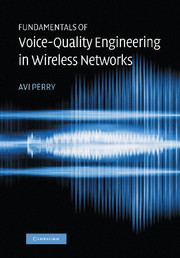Book contents
- Frontmatter
- Contents
- Preface
- List of abbreviations
- Introduction
- Part I Voice-quality foundations
- Part II Applications
- Part III Wireless architectures
- Part IV A network operator's guide for selecting, appraising, and testing a VQS
- Part V Managing the network
- Part VI Afterthoughts and some fresh ideas
- 13 Tracer probe
- 14 My sound
- 15 A procedure for evaluating and contrasting new wireless codecs' performance with and without VQS
- 16 The theory of sleep
- Part VII Recordings
- Glossary of common voice-quality systems terminology
- Brief summary of echo cancelation and VQS major standards
- Brief summary of key voice-quality assessment standards
- Bibliography
- Index
- Frontmatter
- Contents
- Preface
- List of abbreviations
- Introduction
- Part I Voice-quality foundations
- Part II Applications
- Part III Wireless architectures
- Part IV A network operator's guide for selecting, appraising, and testing a VQS
- Part V Managing the network
- Part VI Afterthoughts and some fresh ideas
- 13 Tracer probe
- 14 My sound
- 15 A procedure for evaluating and contrasting new wireless codecs' performance with and without VQS
- 16 The theory of sleep
- Part VII Recordings
- Glossary of common voice-quality systems terminology
- Brief summary of echo cancelation and VQS major standards
- Brief summary of key voice-quality assessment standards
- Bibliography
- Index
Summary
Introduction
My sound is a concept that provides a preferred-user segment (business-class segment) with control over customized sound atmosphere, flavor, clarity, and quality.
Speech and sound quality are an essential part of wireless communications. Unadvertised step-ups and upgrades in network voice-quality capabilities go, for the most part, unnoticed by subscribers, particularly when these capabilities address insufficiencies rather than impairments. For example, echo is a clear impairment while inadequate speech level in the presence of listener noise would be viewed as insufficiency. Intrusive background noise and poor signal-to-noise ratio (SNR), more often than not, would be considered as an insufficiency, while punctured radio coverage and even echo would seize top awareness on the impairment list.
Voice-quality insufficiencies can cross the threshold of a subscriber's awareness (or lack of it) if control over their intensity is given to users throughout or prior to a communication session. The exercise of control may attract users' attention and have them notice and appreciate the enhancement, while simultaneously provide a specific subscriber segment with the pleasure of being in command of their sound output.
One way of letting a subscription-based class of preferred subscribers assume control over certain parameters affecting speech levels and noise-reduction aggressiveness may be implemented via a DTMF sequence, which these users may apply throughout a phone conversation. When striking a DTMF sequence during a call, an authorized user may assume control over the VQS channel he or she is seizing.
- Type
- Chapter
- Information
- Fundamentals of Voice-Quality Engineering in Wireless Networks , pp. 294 - 298Publisher: Cambridge University PressPrint publication year: 2006
- 1
- Cited by



